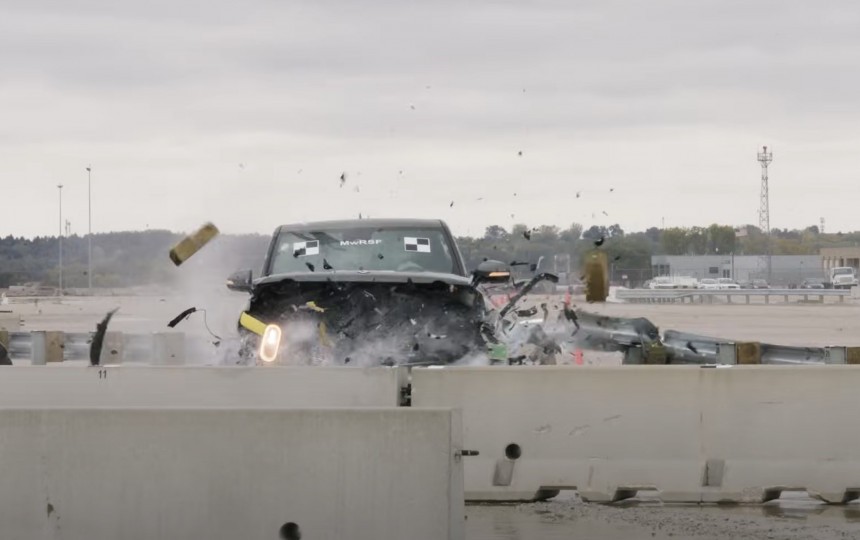Danger can be measured in pounds on the road. And the electric vehicles have plenty of those. In a test meant to prove the danger that large EVs pose to traffic, a Rivian R1T was catapulted into a metal guardrail. The guardrail simply disintegrated.
6.949 pounds or 3,152 kilograms. This is how much the Rivian R1T weighs. It is a massive and ponderous pickup truck that can smash just about anything that comes its way. Guardrails included, as shown by a crash test carried out by the University of Nebraska-Lincoln. The endeavor is sponsored by the Nebraska-based US Army Engineer Research and Development Center (ERDC), and it aims at improving road safety infrastructure.
There are thousands of fatalities resulting each year from more than 100,000 run-off-road crashes involving traffic infrastructure such as guardrails and roadside barriers. The high ground clearance, the reinforced structure that protects the battery pack from being punctured or splintered, and the extra weight that the EVs come with compared to the ICE-powered vehicles turn them into weapons running at high speed on the highway.
And that makes them a danger to incoming traffic as well. A crash test carried out by the University of Nebraska shows the effects of a 2022 Rivian R1T running head-first into a guardrail. The vehicle was catapulted into a standard steel guardrail at 60 mph (97 kph) to check if the guardrail holds up. And it did not.
Guardrails are designed to prevent vehicles from going off the road and falling off cliffs or off bridges or going into oncoming traffic. But they were designed lightyears ago, when heavy EVs were not that popular. The guardrail system used for the test featured a 12-gauge corrugated steel guardrail attached to 6-inch deep steel posts, linked to the rail with blackouts that were 8 to 12 inches thick.
The video shot at the scene shows how the Rivian R1T pickup truck breaks through the steel guardrail as if it wasn't even there. It hardly slows down before smashing into the concrete barriers, jumping over the first one and moving the other one from its place, while parts of the truck fly all around. The concrete barriers were specifically placed behind the metal guardrail to stop the truck.
The Midwest Guardrail System (MGS) has been tested with vehicles that weigh up to 5,000 pounds (2,268 kilograms). But that is a weight that large EVs exceed by far.
The Tesla Cybertruck Foundation Series weighs 6,843 pounds (3,104 kilograms). The Ford F-150 Lightning tips the scales at 6,893 pounds (3,127 kilograms), while the Rivian R1T weighs around 6,000 pounds (2,721 kilograms).
The heaviest of all the zero-emission pickup trucks currently on the market is the Hummer EV, which is rated at a massive 9,046 pounds (4,103 kilograms). And the electric Hummer SUV is no ballerina either.
This means that the guardrail system must be redesigned in order to be more robust and hold up when heavier vehicles are involved. With the ever-growing popularity of zero-emission cars and the weight disparity between them and the ICEs, the move is urgent.
There are thousands of fatalities resulting each year from more than 100,000 run-off-road crashes involving traffic infrastructure such as guardrails and roadside barriers. The high ground clearance, the reinforced structure that protects the battery pack from being punctured or splintered, and the extra weight that the EVs come with compared to the ICE-powered vehicles turn them into weapons running at high speed on the highway.
And that makes them a danger to incoming traffic as well. A crash test carried out by the University of Nebraska shows the effects of a 2022 Rivian R1T running head-first into a guardrail. The vehicle was catapulted into a standard steel guardrail at 60 mph (97 kph) to check if the guardrail holds up. And it did not.
Guardrails are designed to prevent vehicles from going off the road and falling off cliffs or off bridges or going into oncoming traffic. But they were designed lightyears ago, when heavy EVs were not that popular. The guardrail system used for the test featured a 12-gauge corrugated steel guardrail attached to 6-inch deep steel posts, linked to the rail with blackouts that were 8 to 12 inches thick.
The Midwest Guardrail System (MGS) has been tested with vehicles that weigh up to 5,000 pounds (2,268 kilograms). But that is a weight that large EVs exceed by far.
The Tesla Cybertruck Foundation Series weighs 6,843 pounds (3,104 kilograms). The Ford F-150 Lightning tips the scales at 6,893 pounds (3,127 kilograms), while the Rivian R1T weighs around 6,000 pounds (2,721 kilograms).
The heaviest of all the zero-emission pickup trucks currently on the market is the Hummer EV, which is rated at a massive 9,046 pounds (4,103 kilograms). And the electric Hummer SUV is no ballerina either.
This means that the guardrail system must be redesigned in order to be more robust and hold up when heavier vehicles are involved. With the ever-growing popularity of zero-emission cars and the weight disparity between them and the ICEs, the move is urgent.









